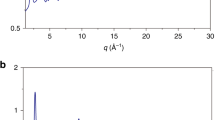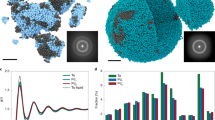Abstract
Characterizing the nature of medium-range order (MRO) in liquids and disordered solids is important for understanding their structure and transport properties. However, accurately portraying MRO, as manifested by the first sharp diffraction peak (FSDP) in neutron and X-ray scattering measurements, has remained elusive for more than 80 years. Here, using X-ray diffraction of amorphous red phosphorus compressed to 6.30 GPa, supplemented with micro-Raman scattering studies, we build three-dimensional structural models consistent with the diffraction data. We discover that the pressure dependence of the FSDP intensity and line position can be quantitatively accounted for by a characteristic void distribution function, defined in terms of average void size, void spacing and void density. This work provides a template to unambiguously interpret atomic and void-space MRO across a broad range of technologically promising network-forming materials.
This is a preview of subscription content, access via your institution
Access options
Subscribe to this journal
Receive 12 print issues and online access
$259.00 per year
only $21.58 per issue
Buy this article
- Purchase on Springer Link
- Instant access to full article PDF
Prices may be subject to local taxes which are calculated during checkout




Similar content being viewed by others
References
Tawada, Y., Tsuge, K., Kondo, M., Okamoto, H. & Hamakawa, Y. Properties and structure of alpha-SiC–H for high-efficiency alpha-Si solar-cell. J. Appl. Phys. 53, 5273–5281 (1982).
Kalkhoran, N. M, Namavar, F. & Maruska, H. P. Optoelectric applications of porous polycrystalline silicon. Appl. Phys. Lett. 63, 2661–2663 (1993).
Kohara, S. et al. Structural basis for the fast change of Ge2Sb2Te5: Ring statistics analogy between the crystal and amorphous states. Appl. Phys. Lett. 89, 201910 (2006).
Wang, Y., Li, J., Hamza, A. V. & Barbee, T. W. Ductile crystalline line-amorphous nanolaminates. Proc. Natl Acad. Sci. 104, 11155–11160 (2007).
Lucovsky, G. Specification of medium range order in amorphous materials. J. Non-Cryst. Solids 97, 155–158 (1987).
Popescu, M. A. Hole structure of computer models of non-crystalline materials. J. Non-Cryst. Solids 35, 549–554 (1980).
Elliott, S. R. Medium range order in covalent amorphous solids. Nature 354, 445–452 (1991).
Bhatia, A. B. & Thorton, D. E. Structural aspects of the electrical resistively of binary alloys. Phys. Rev. B 2, 3004–3012 (1970).
Elliott, S. R. Origin of the first sharp diffraction peak in the structure factor of covalent glasses. Phys. Rev. Lett. 67, 711–714 (1991).
Lannin, J. S. & Shanabrook, B. V. Intermediate range order in amorphous red phosphorus. J. Non-Cryst. Solids 49, 209–218 (1982).
Lannin, J. S. & Shanabrook, B. V. Raman scattering and infrared absorption in amorphous red phosphorus. Solid State Commun. 28, 497–500 (1978).
Shanabrook, B. V., Lannin, J. S. & Taylor, P. C. Far infrared absorption in bulk amorphous red phosphorous. Solid State Commun. 32, 1279–1283 (1979).
Goodman, N. B., Ley, L. & Bullett, D. W. Valence-band structures of phosphorus allotropes. Phys. Rev. B 27, 7440–7450 (1983).
Wilson, M. & Madden, P. A. Voids, layers, and the first sharp diffraction peak in ZnCl2 . Phys. Rev. Lett. 80, 532–535 (1998).
Fowler, T. G. & Elliott, S. R. Continuous random network models for a-As2S3 . J. Non-Cryst. Solids 92, 31–50 (1987).
Susman, S., Volin, K. J., Montague, D. G. & Price, D. L. Temperature dependence of the first sharp diffraction peak in vitreous silica. Phys. Rev. B 43, 11/076-081 (1991).
Viščor, P. Structure and the existence of the first sharp diffraction peak in amorphous germanium prepared in UHV and measured in-situ. J. Non-Cryst. Solids 97, 179–182 (1987).
Vepřek, S. & Beyeler, H. U. On the interpretation of the first, sharp maximum in the X-ray scattering pattern of non-crystalline solids and liquids. Phil. Mag. B 44, 557–567 (1981).
Wilson, M., Madden, P. A., Medvedev, N. N., Geiger, A. & Appelhagen, A. Voids in network forming liquids and their influences on the structure and dynamics. J. Chem. Soc. Faraday Trans. 94, 1221–1228 (1998).
Hultgren, R., Gingrich, N. S. & Warren, B. E. The atomic distribution in red and black phosphorus and the crystalline structure of black phosphorus. J. Chem. Phys. 3, 351–355 (1935).
Krebs, H. & Gruber, H. U. The atomic distribution in glassy red phosphorus. Z. Naturf. 22a, 96–102 (1967).
Tsvigunov, A. N. X-ray study of the allotropic conversions of amorphous red phosphorus at high pressure and temperature. Russ. J. Phys. Chem. 51, 1331–1333 (1979).
Durig, J. R. & Casper, J. M. On the vibrational spectra and structure of red phosphorus. J. Mol. Struct. 5, 351–358 (1970).
Olego, D. J. et al. The microscopic structure of bulk amorphous red phosphorus: A Raman scattering investigation. Solid State Commun. 52, 311–314 (1984).
Shanabrook, B. V., Bishop, S. G. & Taylor, P. C. Photo-luminescence and electron-spin-resonance studies of localized states in amorphous phosphorus. J. Physique 42, C4–C865 (1981).
Long, L. J., Guarise, G. B. & Marani, A. Phase transitions of phosphorus at high pressure. Corsi. Semin. Chim. 5, 97–104 (1967).
Extance, P. & Elliott, S. R. Pressure dependence of the electrical conductivity of amorphous red phosphorus. Phil. Mag. B 43, 469–483 (1980).
Sorgoto, I., Guarise, G. B. & Marini, A. Red to black phosphorus transition up to 65 kbar. High Temp.– High Pressures 2, 405–111 (1970).
Phillips, R. T. & Sobiesierski, Z. Recombination in amorphous red phosphorus. J. Phys. C 20, 4259–4269 (1987).
Depinna, S. & Cavenett, B. C. Radiative recombination in amorphous phosphorus. J. Phys. C 16, 7063–7080 (1983).
Elliott, S. R., Dore, J. C. & Marseglia, E. The structure of amorphous phosphorus. J. Phys. Colloq. 46, C8–C349 (1985).
Farmen, H., Blakely, D., Dore, J. C., Bellissent-Funel, M.-C. & Elliott, S. R. Neutron diffraction studies of network structures in amorphous phosphorus. Phys. Scr. 49, 634–636 (1994).
Jones, R. O. & Hohl, D. Structure of phosphorus clusters using simulated annealing— P2 to P8 . J. Chem. Phys. 92, 6710–6721 (1990).
Jóvári, P. & Pusztai, L. On the structure of amorphous red phosphorus. Appl. Phys. A 74, S1092–S1094 (2002).
Jürgensen, A. The P(1s) and P(2p) XAFS spectra of elemental phosphorus, theory and experiment. Phys. Scr. T115, 548–551 (2005).
Ruck, M. et al. Fibrous red phosphorus. Angew. Chem. Int. Ed. 44, 7616–7619 (2005).
Fasol, G., Cardona, W., Hönle, W. & v Schnering, H. G. Lattice dynamics of Hittorf’s phosphorus and identification of structural defects in amorphous phosphorus. Solid State Commun. 52, 307–310 (1984).
Jones, R. O. & Hohl, D. Structure of phosphorus clusters using simulated annealing P2 to P8 . J. Chem. Phys. 92, 6710–6721 (1990).
Hohl, D. & Jones, R. O. Amorphous phosphorus: A cluster-network model. Phys. Rev. B 45, 8995–9005 (1992).
Böcker, S. & Häser, M. Covalent structures of phosphorus: A comprehensive theoretical study. Z. Anorg. Allg. Chem. 621, 258–286 (1995).
Song, B., Cao, P.-L., Zhao, W. & Li, B.-X. The structure of P8 and P9 clusters. Phys. Status. Solidi. B 226, 305–314 (2001).
Greaves, G. N., Elliott, S. R. & Davis, E. A. Amorphous arsenic. Adv. Phys. 28, 49–141 (1979).
Soper, A. K. Partial structure factors from disordered materials diffraction data: An approach using empirical potential structure refinement. Phys. Rev. B 72, 104204 (2005).
Soper, A. K. The excluded volume effect in confined fluids and liquid water. J. Phys. Condens. Matter 9, 2399–2410 (1997).
Percus, J. K. & Yevick, G. J. Analysis of classical statistical mechanics by means of collective coordinates. Phys. Rev. 110, 1–13 (1958).
v Zernike, F. & Prins, J. A. X-ray diffraction to determine molecular structure in fluids. Z. F. Phys. 41, 184–194 (1927).
Debye, P. X-ray scattering. Ann. Phys. (Leipzig) 46, 809–823 (1915).
Eggert, J. H., Weck, G., Loubeyre, P. & Mezouar, M. Quantitative structure factor and density measurements of high-pressure fluids in diamond anvil cells by x-ray diffraction: Argon and water. Phys. Rev. B 65, 174105 (2002).
Kunz, M. et al. A beamline for high pressure studies at the Advanced Light Source with a superconducting bending magnet as the source. J. Synchrotron. Radiat. 12, 650–658 (2005).
Acknowledgements
J.M.Z. thanks J. Molitoris for sparking an interest to study a-rP, M. Bastea for providing a-rP sample material and C. Thompson of www.mathengineering.com for Matlab consulting and code acceleration tips. We thank J. Eggert for his guidance to properly determine density from high-pressure diffraction data. This work was carried out under the auspices of the US Department of Energy jointly by Lawrence Livermore National Laboratory under Contract DE-AC52-07NA27344. The Advanced Light Source is supported by the Director, Office of Science, Office of Basic Energy Sciences, of the US Department of Energy under Contract DE-AC03-76SF00098.
Author information
Authors and Affiliations
Contributions
J.M.Z. devised the project and design engineered the ultrawide-aperture DAC. J.M.Z. and S.M.C. conducted X-ray experiments and subsequent data reductions. J.M.Z. conducted micro-Raman scattering experiments and corresponding data analysis. A.K.S. carried out EPSR analysis of diffraction data. J.M.Z. and A.K.S. wrote the manuscript.
Corresponding author
Supplementary information
Supplementary Information
Supplementary Information (PDF 928 kb)
Rights and permissions
About this article
Cite this article
Zaug, J., Soper, A. & Clark, S. Pressure-dependent structures of amorphous red phosphorus and the origin of the first sharp diffraction peaks. Nature Mater 7, 890–899 (2008). https://doi.org/10.1038/nmat2290
Received:
Accepted:
Published:
Issue Date:
DOI: https://doi.org/10.1038/nmat2290
This article is cited by
-
Role of S/Se replacement on the structure of Ge20Se80-xSx glasses
Indian Journal of Physics (2023)
-
Preparation, Characterization, and Performance of Lignin-based Microencapsulated Red Phosphorus Flame Retardant for ABS
Journal of Wuhan University of Technology-Mater. Sci. Ed. (2022)
-
Ultra-Thin Red Phosphor Nanosheets as an Efficient Photocatalyst for Hydrogen Evolution Under Visible Light
Topics in Catalysis (2021)
-
A general-purpose machine-learning force field for bulk and nanostructured phosphorus
Nature Communications (2020)
-
Mechanochemical conversion kinetics of red to black phosphorus and scaling parameters for high volume synthesis
npj 2D Materials and Applications (2020)



